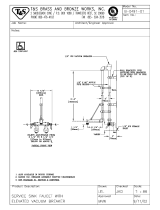
OM-HH
11
WARNING
AVOID DIRECT CONTACT WITH HOT FOOD
OR WATER IN THE KETTLE. DIRECT
CONTACT COULD CAUSE SEVERE BURNS.
(4) Slowly lower product into kettle and
securely hook the basket to the “Y” frame.
(5) When removing baskets with cooked
product, lift straight up, ensuring baskets
clear the kettle rim. Wear protective oven
mitts and protective apron
(6) Allow hot water to fully drain from product,
before moving basket away from the kettle.
If baskets are too heavy, get help. Remove
product immediately from basket into
another container, being sure to avoid
contact with hot product and hot basket.
(7) Place baskets with food on a stable, flat
surface, or inside a solid steamer or bake
pan, to catch any remaining hot water
draining from product.
Sequence of Operation
The following “action-reaction” outline will help the
user understand how the equipment works.
A. Model HH/4 with Standing Pilot Ignition
Pressing the reset button overrides the automatic
control and opens the pilot burner valve, allowing
gas from the supply line into the pilot. Lighting and
sustaining the pilot flame for 60 seconds heats the
thermocouple to operating temperature, so that it
can supply electric current at 20 to 25 millivolts.
Current from the thermocouple powers a coil that
holds the pilot burner valve open. If the pilot flame
goes out and the thermocouple cools, the valve
closes and prevents gas flow into the unit.
Once the pilot burner valve opens, gas is available
at the main burner valve, which is normally closed.
Pushing the toggle switch to “ON” provides 120 Volt
electric power to the thermostat. When the operator
turns the thermostat dial to a setting, the switch
closes and allows power to the heating indicator
light and a coil at the main burner valve. The coil
opens the main burner valve. Gas then flows to the
main burner where it is ignited by the pilot flame.
B. Model HH/4/E with Electronic Spark Ignition
Pressing the toggle switch “ON”, supplies electric
power to the thermostat. Turning the dial to an
operating setting closes the thermostat switch and
energizes the gas control. Simultaneously, an arc is
established at the spark gap, and the pilot burner
automatic valve is opened. When the spark ignites
gas flowing from the pilot burner, a pilot flame probe
detects the flame. The probe sends a signal to shut
the spark off and close the circuit. This provides
power for the indicator light and the main automatic
valve. Gas from the main burner is ignited by the
pilot flame. If a pilot flame is not sensed within 30
seconds, a timer shuts down the whole operation.
C. All Units
As main burner heat raises steam temperature to
the set temperature, the thermostat switch opens.
This cuts power to the main burner valve, which
closes and turns off the burner. When jacket steam
cools below the set point, the thermostat switch
closes and begins another cycle. This repeats to
maintain the kettle at the desired temperature.
The thermostat controls heating by alternately
calling for flames at main burner full capacity or
signaling the control to shut the burner off.
Because the control works in this “all or nothing”
way, the kettle heats as fast as it can until it reaches
a set temperature. Turning the thermostat higher
only makes heating continue longer. It will not make
the unit heat any faster.
Safety features operate as follows:
1. Pressure limit switch: If pressure in the jacket
exceeds 27 PSI, the switch opens and breaks
the circuit at the main gas valve. The valve
closes and remains closed until pressure drops
to 22 PSI. The switch then closes, energizes
the gas valve coil, and permits operation to
resume.
2. Low-water cutoff: As long as water touches the
cutoff electrode in the jacket, operation of the
kettle can continue. If the water level falls below
the end of the electrode, a control circuit
breaks, and the main gas valve closes. Jacket
water must be restored to a safe operating
level, before the kettle can be heated again.
3. Safety valve: If steam pressure in the jacket
reaches 30 PSI, the valve will open and relieve
the excess pressure.




















